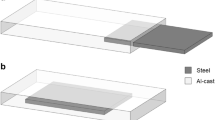Abstract
The aim of this work is to optimize the geometric form of additional plastic working elements of shock absorbers for various cases of impact loading. A finite-element model of a plastic element was used to evaluate the stressed state generated in cases of coupling of heavy freight trains with various types of mandrel. The results of numerical simulation show that application of a plastic working element with a convex generating line of mandrel is optimal for damping shock loads and minimizing damage during collisions.
Similar content being viewed by others
REFERENCES
Automatische Mittelpufferkupplung, European Patent Application No. 0608531 of 13.12.93.
Central Buffer Coupling, Patent Application GB No. 2173755 of 10.04.85.
A. Boiko, Research of Shock Processes and Substantiation of Ways to Increase Railway Car Safety at Collisions [in Russian], Master's Degree Thesis, Riga Technical University (1997).
F. Cook and S. Mark, “Multibody dynamic simulation of the rail impact test,” in: Proc. of the Society for Computer Simulation, Int. Summer Computer Simulation Conference (1997).
The ANSYS User's Manual, Vol. 4, Theory, Release 5.6 (2000).
Author information
Authors and Affiliations
Rights and permissions
About this article
Cite this article
Boiko, A. Energy Absorption Optimization of Multiaction Plastic Working Element of Vehicle Systems under Emergency Impact Loading Conditions. Strength of Materials 34, 305–309 (2002). https://doi.org/10.1023/A:1016287120698
Issue Date:
DOI: https://doi.org/10.1023/A:1016287120698




